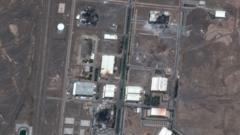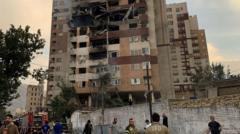In his latest defense initiative, Donald Trump has announced plans for a sophisticated missile defense system dubbed the "Golden Dome," designed to protect the U.S. from emerging geopolitical threats. While experts agree on the necessity of modernizing missile defenses, estimates suggest that the ambitious project could exceed initial budgetary projections and prompt potential escalations in global military tensions.
Trump's Ambitious Vision: The Golden Dome Missile Defense System

Trump's Ambitious Vision: The Golden Dome Missile Defense System
As missile threats increase globally, Donald Trump's proposed "Golden Dome" aims to bolster U.S. missile defense but faces significant financial and technical hurdles.
Given the ever-evolving threat from advanced missile technology and geopolitical tensions, experts are ringing alarm bells about the limitations of America's existing defense systems. Recent scenarios presented by defense analysts paint a grim picture of U.S. infrastructure vulnerability to high-tech attacks, including nuclear detonations that could result in catastrophic electromagnetic pulses. William Fortschen, a recognized expert in weapons research, warns that such an event could set the nation back centuries in terms of technological advancement and infrastructure resilience.
In light of these potential threats, President Trump has announced the ambitious "Golden Dome" project, which aims to establish a next-generation missile defense system in the United States. While many analysts emphasize the urgent need for an upgrade to the country's defense strategy, they also point to the complexities and staggering costs associated with implementing such a system. According to Trump's executive order, the rising danger from next-generation weapons positions the U.S. in a precarious situation that must be addressed.
Patrycja Bazylczyk from the Center for Strategic and International Studies highlights that existing defenses primarily target intercontinental ballistic missiles (ICBMs), leaving a gap against newer technologies such as hypersonic weapons. These advancements pose a significant threat from nation-state adversaries like Russia and China. Bazylczyk asserts the necessity of a system that goes beyond traditional defense techniques to include layered capabilities that integrate various technologies across land, sea, and space.
Although details regarding the Golden Dome remain sparse, Trump's vision includes its ability to intercept threats launched from anywhere in the world, even from space. The system's initial roll-out could see facilities spread across states like Florida, Indiana, and Alaska, with hopes for rapid implementation before the conclusion of Trump's term. However, experts caution that the real financial burden could be much higher than Trump's estimates; the Congressional Budget Office projects expenditures that could surpass $540 billion over two decades for just the space-based aspects.
Trump's comparison of the Golden Dome to Israel's successful Iron Dome highlights the motivation behind his initiative. However, analysts argue that the Iron Dome primarily addresses short-range threats, while the Golden Dome would need to tackle more sophisticated and lethal capabilities. Bazylczyk points out that developing a robust integrated command and control system is essential for the Golden Dome’s effectiveness.
Despite the project's potential benefits, there are concerns regarding an arms race and escalated international tensions sparked by the U.S. efforts to enhance its missile defense. China's representatives have voiced their apprehension that the initiative may turn space into a battleground, increasing risks globally.
Ultimately, while the Golden Dome could initially serve as a deterrent and help strengthen national security, experts assert that successfully navigating technical, financial, and strategic challenges will be paramount. The consensus remains that the proposed system could indeed transform the defense landscape if effectively developed and deployed.
In light of these potential threats, President Trump has announced the ambitious "Golden Dome" project, which aims to establish a next-generation missile defense system in the United States. While many analysts emphasize the urgent need for an upgrade to the country's defense strategy, they also point to the complexities and staggering costs associated with implementing such a system. According to Trump's executive order, the rising danger from next-generation weapons positions the U.S. in a precarious situation that must be addressed.
Patrycja Bazylczyk from the Center for Strategic and International Studies highlights that existing defenses primarily target intercontinental ballistic missiles (ICBMs), leaving a gap against newer technologies such as hypersonic weapons. These advancements pose a significant threat from nation-state adversaries like Russia and China. Bazylczyk asserts the necessity of a system that goes beyond traditional defense techniques to include layered capabilities that integrate various technologies across land, sea, and space.
Although details regarding the Golden Dome remain sparse, Trump's vision includes its ability to intercept threats launched from anywhere in the world, even from space. The system's initial roll-out could see facilities spread across states like Florida, Indiana, and Alaska, with hopes for rapid implementation before the conclusion of Trump's term. However, experts caution that the real financial burden could be much higher than Trump's estimates; the Congressional Budget Office projects expenditures that could surpass $540 billion over two decades for just the space-based aspects.
Trump's comparison of the Golden Dome to Israel's successful Iron Dome highlights the motivation behind his initiative. However, analysts argue that the Iron Dome primarily addresses short-range threats, while the Golden Dome would need to tackle more sophisticated and lethal capabilities. Bazylczyk points out that developing a robust integrated command and control system is essential for the Golden Dome’s effectiveness.
Despite the project's potential benefits, there are concerns regarding an arms race and escalated international tensions sparked by the U.S. efforts to enhance its missile defense. China's representatives have voiced their apprehension that the initiative may turn space into a battleground, increasing risks globally.
Ultimately, while the Golden Dome could initially serve as a deterrent and help strengthen national security, experts assert that successfully navigating technical, financial, and strategic challenges will be paramount. The consensus remains that the proposed system could indeed transform the defense landscape if effectively developed and deployed.



















